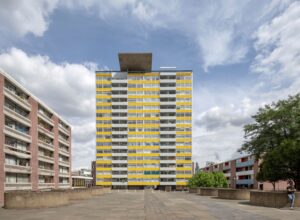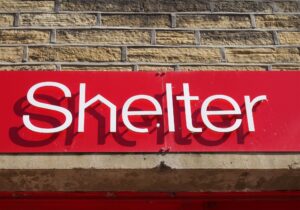For decades retail has been seen as the driver of regeneration of our towns and cities. But in his new book, Julian Dobson finds little prosperity behind the glossy exteriors.
If you stroll down the hill from Liverpool’s Lime Street station towards the city centre and the historic waterfront, you’ll find it hard to avoid Liverpool One.
Liverpool One is retail-led regeneration in all its splendour. Spread over 42 acres of prime real estate, it is a brightly lit, glass-fronted apogee of cash-till urbanism, with 165 shops, 500 apartments, two hotels, 25 restaurants, 30,000 square feet of offices and a 14-screen cinema. This billion-pound shopping nirvana was designed to bring new life to a city that had fallen on hard times, and its combination of big retail convenience and city centre setting has brought the crowds flooding in.
The Royal Institute of British Architects swooned over the project, completed in October 2008. The judges of their regional awards declared: ‘The Liverpool One Masterplan has single-handedly reversed the fortunes of the city by bringing a new social and economic vibrancy. The result is a vibrant and economically successful retail, leisure and mixed-use quarter – an entirely revitalised city centre that now connects properly with the docks.’
Libraries of technical expertise went into making Liverpool One the antithesis of the big-box retail park. Historic street patterns are respected, there are variations of scale and style, and there is open space for weary shoppers in the form of Chavasse Park at the western end of the development. It may all be privately owned and controlled, but that doesn’t bother the punters at the big stores.
The story of retail-led regeneration is one
of concentration, polarisation and anonymisation
Liverpool One is, on the face of it, an icon of how a city can retell its tale through retail. It seeks to demonstrate that you can keep one eye on the past while both are firmly focused on the bottom line. It’s a story that is celebrated by city planners as distinctively Liverpudlian, yet it is chock full of the ubiquitous names you’ll find in every major shopping centre, from John Lewis to Fat Face.
The entire development is owned and managed by Grosvenor Estates, the property company owned by the anything-but-Scouse Duke of Westminster. In an extended panegyric, the Observer architecture correspondent Stephen Bayley described the development as ‘seemingly evolved’ and designed to ‘provide a controlled level of diversity’. All human life is there, as long as it can be boxed and gift-wrapped, and subject to the store’s usual returns policy.
There’s no doubt that Liverpool One contains the ingredients of a successful shopping centre. It has variety of design, it has the stores people like to use, it is easy to walk through, it’s clean and modern, and there are plenty of leisure facilities for those whose shopping stamina has been drained. All the evidence is that Liverpool One brings in visitors from a very wide catchment area to spend a great deal of money.
And there’s the rub. The story of place that Liverpool One tells can’t be disentangled from the stories of the surrounding places that are less glitzy and far more gloomy: Kirkby, Huyton, Birkenhead and Bootle. Merseyside is a place of contrasts, contested identities and rough edges, none of which have a place in the manicured environment of Liverpool One.
Nearby Bootle and Runcorn are among the ‘worst-performing’ centres in northwest England, according to the Local Data Company. The wealth of Liverpool One is not additional, because people are not better off: it is a billion-pound wealth redistribution scheme, with the redistribution heading in the wrong direction.
There’s no doubt that Liverpool One has brought shopping back to Liverpool. According to Grosvenor, the city had slumped from third in England’s retail pecking order in the 1970s to 17th by 1995; after the opening of Liverpool One it bounced back to fifth and brought an extra 43,000 shoppers into the city. But as Grosvenor itself points out, this has been achieved by drawing in more people from the surrounding areas of the Wirral, Chester and Southport. Trickle-down has been replaced by hoover-up.
Well, one might argue, that’s market forces: if the surrounding areas want to compete, they too need to invest in the shops and leisure facilities customers want. But who’ll invest in a town like Wigan, just 22 miles from Liverpool city centre, with two indoor shopping centres (one already on its last legs) and a market that has seen better days?
Projects like Liverpool One don’t create wealth so much as concentrate it. Those trumpeting the city’s transformation may feel a legitimate pride in the development, but there are statistics they are less willing to shout about. Out of 64 UK cities, according to the Centre for Cities, Liverpool ranked 56th for population growth in 2014; it was 57th for the number of businesses per head of population; 55th in terms of jobseekers claiming benefits; and 62nd for its employment rate. Liverpool One may have brought shoppers into the city, but it has not brought prosperity.
The story of retail-led regeneration is one of concentration, polarisation and anonymisation. Developers like Land Securities want their shopping centres to be world-class: for that, read ‘could be anywhere’. LandSec’s marketing for Trinity Leeds, for example, describes ‘a growing mix of restaurant, café and leisure destinations that will seamlessly join day with night, ushering into the city a new era of world-class entertainment and culture’. Substitute Trinity Leeds for Gunwharf Quays in Portsmouth, Cabot Circus in Bristol or Buchanan Galleries in Glasgow and scarcely a word of the spiel will need to change.
Liverpool One shopping centre at nightTowns suffer ‘root shock’ from retail-led regeneration
For the winners the prizes are self-evident. But the notion that every town and city can prosper in competition with neighbours pursuing the self-same strategy of debt-fuelled development and the accumulation of bigger and brighter retail space defies credulity: there will always be losers, and some will lose spectacularly.
Nobody imagines, though, that it will be them. Town after town swallowed the bait of retail-led regeneration in the early 2000s, with its smooth-talking consultants and computer-generated images of happy, shiny people strolling along sunlit shopping boulevards; and many continue to swallow it.
In 2009 one of the few independent studies of the phenomenon exposed the knowledge gap at the heart of these efforts to reinvigorate town centres. In their comprehensive literature review, Anne Findlay and Leigh Sparks emphasised that despite many years of activity under the banner of retail-led regeneration, there was little comparable evidence of effectiveness and no study showing how schemes were working over a sustained period.
‘Assessment of policy effectiveness is partial, piecemeal and subjective,’ they concluded. Furthermore, they argued, the term ‘regeneration’ encompassed such a wide variety of aims and means that it often obscured rather than clarified understanding.
We need to widen our horizons, and think in terms of how
town centres can be creative and resilient enough to face the future
While the developers of the likes of Trinity Leeds and Liverpool One can crow about the number of jobs they have created or investment they have brought in, their statistics fail to measure what has been displaced from elsewhere. As with most development schemes, private or public, there is a constant temptation to over-egg the claimed benefits and to neglect to measure the downsides.
The impact of schemes like Liverpool One needs to be seen in a broader context. In the process of creating a new narrative for one city or town, stories are also written for the places that surround them.
Economists and the property industry seldom try to measure the value of what is displaced. But this displacement – literally, the loss of place – matters. The psychologist Mindi Fullilove calls it ‘root shock’, borrowing the term from horticulture: when a plant is taken out of the soil where it grew and is transplanted elsewhere, its survival systems can suddenly collapse.
Professor Fullilove uses this metaphor to describe the effect of urban change on people. Her work examines urban regeneration schemes in the US, the state of North American Main Streets, and the impact on New York and New Jersey of Hurricane Sandy. Whole towns can suffer from a kind of root shock if the industries or facilities that kept them going disappear, and schemes sold to urban leaders and the public as retail-led regeneration can often be part of that process of obliteration rather than an antidote to it.
Narrowly-focused debates about how traditional high streets can compete commercially with new retail developments often fail to acknowledge such connections and complexities. We need to widen our horizons, and think instead in terms of how town centres can be creative and resilient enough to face the future.
In How to Save Our Town Centres, I bring together examples of how this has been done and ideas of what we could do in the future. It can be as simple as growing and sharing food in a town like Todmorden in west Yorkshire, where edible plantings have been used as a way of rethinking public space and the town’s identity; or it could be as ambitious as taking on the transformation of a whole neighbourhood for the benefit of the community, which is what has happened in Boston in the US (see next page).
My book is about shifting the mindset that says that only people with big wallets can make big changes; and the values that put narrow measures of short-term economic growth above the interests of the generations that will inherit the places we create – if create is the right word for what we are doing to many of our towns and cities. As one reader commented on Twitter, ‘I can hear the [property] industry hating it from here!’
The Dudley Real Food Hub, part of the Dudley Street Neighbourhood InitiativeBy the people, for the people: Dudley Street Neighborhood Initiative
Over a period of 30 years the Dudley Street Neighborhood Initiative has turned the burned-out and abandoned heart of one of Boston’s poorest districts into a thriving and culturally diverse community, led and managed by local residents. This was an area that had seen devastation on a scale comparable to the Bronx in the 1970s. Owners of empty buildings – and many that were still occupied – would routinely arrange for them to be torched in order to collect insurance payments and clear the way for speculative development.
The Dudley Street Neighborhood Initiative began with opposition to plans that would have bulldozed local residents’ homes and moved out some of the poorest people in the city. Its organisers contrast their homespun vision for the future with the urban competitiveness theories of Harvard economist Michael Porter, whose view of cities’ life and functions has strongly influenced city leaders worldwide.
Economic development in conventional business terms, they point out, is a far cry from economic power for local residents, and from the networks of families and festivities that bring life to a metropolis. Their idea of an urban village is to provide ‘a living example of how a community can successfully achieve social and economic goals while maintaining control over its destiny’.
Today, despite the continuing challenges of poverty and unemployment and the social stresses that go with them, Dudley Street has become a model for ‘development without displacement’. By setting up a community land trust, which vests ownership of the land in a non-profit trust in perpetuity, it has been able to provide the only permanently affordable housing in the city of Boston.
Astonishingly – and only after years of legal challenges – it has managed to acquire ‘eminent domain’ powers, the equivalent of compulsory purchase powers in the UK. This has enabled Dudley Street Neighborhood Initiative to force negligent landowners to sell abandoned property within a 60-acre triangle to the community.
The land trust, known as Dudley Neighbors, Inc., has been able to build 400 new affordable homes, a ‘town common’, schools and community centres, parks, gardens and a community greenhouse and orchard. By saving and restoring the area as a place to live, it has been able to improve public spaces and revive commercial activity.
- This article is based on extracts from How to Save Our Town Centres, published by Policy Press and available at www.policypress.co.uk or www.urbanpollinators.co.uk
















Leave a Reply